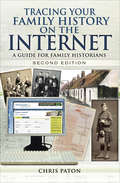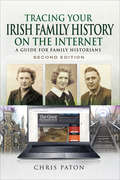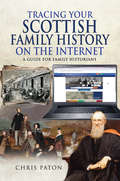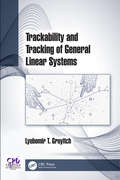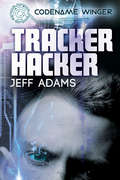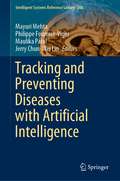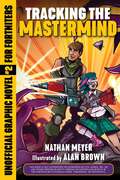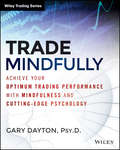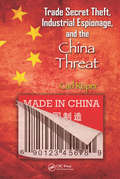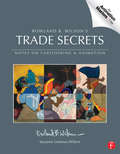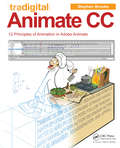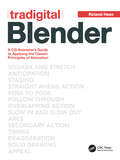- Table View
- List View
Traceable Human Experiment Design Research: Theoretical Model and Practical Guide
by Nadine MandranThe aim of this book is to describe the methodology of conducting the THEDRE research "Traceable Human Experiment Design Research". It applies to Research in Human Centered Informatics (RICH). These are areas of computer research that integrate users to build scientific knowledge and supporting tools for this research. As an example, we can mention the relevant fields such as Information Systems (IS), Human Machine Interfaces (HMI) Engineering, and Human Information Systems (HIA). The construction of this language and method is based on experiments conducted since 2008 in the field of RICH.
Traceback and Anonymity
by Xinyuan Wang Douglas ReevesThis brief systematically examines the trackback problem and its interaction with low-latency anonymous communication. First, it provides an overview of the common techniques a network-based attack may use to hide its origin and identity. Then the authors explore the MIX-based anonymity and the building blocks of low-latency anonymous communication. Later chapters offer a comprehensive study of the timing attacks on low-latency anonymous communication, and analyze the fundamental limitations of low-latency anonymous communication from the perspective of timing-based covert channel. Suitable for professionals and researchers, Traceback and Anonymity is a close look at a key aspect of cyber security studies. Advanced-level students interested in cyber security techniques or networking will also find the content valuable.
Tracing Your Family History on the Internet, Second Edition: A Guide for Family Historians (Tracing Your Ancestors Ser.)
by Chris PatonThis fully revised second edition of Chris Paton's best-selling guide is essential reading if you want to make effective use of the internet in your family history research. Every day new records and resources are placed online and new methods of sharing research and communicating across cyberspace become available, and his handbook is the perfect introduction to them. He has checked and updated all the links and other sources, added new ones, written a new introduction and substantially expanded the social networking section. Never before has it been so easy to research family history using the internet, but he demonstrates that researchers need to take a cautious approach to the information they gain from it. They need to ask, where did the original material come from and has it been accurately reproduced, why was it put online, what has been left out and what is still to come? As he leads the researcher through the multitude of resources that are now accessible online, he helps to answer these questions. He shows what the internet can and cannot do, and he warns against the various traps researchers can fall into along the way.As seen in Your Family Tree Magazine.
Tracing Your Irish Family History on the Internet, Second Edition: A Guide for Family Historians (Tracing Your Ancestors)
by Chris PatonA simple, easy-to-use guide to tracing your Irish ancestry via the Internet. In this, the fully updated second edition of his best-selling guide to researching Irish history using the Internet, Chris Paton shows the extraordinary variety of sources that can now be accessed online. Although Ireland has lost many records that would have been of great interest to family historians, he demonstrates that a great deal of information survived and is now easily available to the researcher. Thanks to the pioneering efforts of the Public Record Office of Northern Ireland, the National Archives of Ireland, organizations such as FindmyPast Ireland, Ancestry.co.uk, and RootsIreland and the volunteer genealogical community, an ever-increasing range of Ireland&’s historical resources are accessible from afar. As well as exploring the various categories of records that the family historian can turn to, Chris Paton illustrates their use with fascinating case studies. He fully explores the online records available from both the north and the south from the earliest times to the present day. Many overseas collections are also included, and he looks at social networking in an Irish context where many exciting projects are currently underway. Paton&’s book is an essential introduction and reference for anyone who is keen to trace their Irish roots.
Tracing Your Scottish Family History on the Internet: A Guide for Family Historians (Tracing Your Ancestors)
by Chris PatonFrom search engines and databases to DNA platforms, discover how to easily learn more about your Scottish ancestry online with this helpful guide.Scotland is a land with a proud and centuries long history that far predates its membership of Great Britain and the United Kingdom. Today in the 21st century it is also a land that has done much to make its historical records accessible, to help those with Caledonian ancestry trace their roots back to earlier times and a world long past.In Tracing Scottish Family History on the Internet, Chris Paton expertly guides the family historian through the many Scottish records offerings available, but also cautions the reader that not every record is online, providing detailed advice on how to use web based finding aids to locate further material across the country and beyond. He also examines social networking and the many DNA platforms that are currently further revolutionizing online Scottish research.From the Scottish Government websites offering access to our most important national records, to the holdings of local archives, libraries, family history societies, and online vendors, Chris Paton takes the reader across Scotland, from the Highlands and Islands, through the Central Belt and the Lowlands, and across the diaspora, to explore the various flavors of Scottishness that have bound us together as a nation for so long.
Tracing the Life Cycle of Ideas in the Humanities and Social Sciences: A Portrait Of A Discipline Through Analyses Of Scientific Literature (Quantitative Methods in the Humanities and Social Sciences)
by Arjuna TuzziThis book demonstrates how quantitative methods for text analysis can successfully combine with qualitative methods in the study of different disciplines of the Humanities and Social Sciences (HSS). The book focuses on learning about the evolution of ideas of HSS disciplines through a distant reading of the contents conveyed by scientific literature, in order to retrieve the most relevant topics being debated over time. Quantitative methods, statistical techniques and software packages are used to identify and study the main subject matters of a discipline from raw textual data, both in the past and today. The book also deals with the concept of quality of life of words and aims to foster a discussion about the life cycle of scientific ideas. Textual data retrieved from large corpora pose interesting challenges for any data analysis method and today represent a growing area of research in many fields. New problems emerge from the growing availability of large databases and new methods are needed to retrieve significant information from those large information sources. This book can be used to explain how quantitative methods can be part of the research instrumentation and the "toolbox" of scholars of Humanities and Social Sciences. The book contains numerous examples and a description of the main methods in use, with references to literature and available software. Most of the chapters of the book have been written in a non-technical language for HSS researchers without mathematical, computer or statistical backgrounds.
Track Changes: A Literary History of Word Processing
by Matthew G. KirschenbaumWriting in the digital age has been as messy as the inky rags in Gutenberg's shop or the molten lead of a Linotype machine. Matthew Kirschenbaum examines how creative authorship came to coexist with the computer revolution. Who were the early adopters, and what made others anxious? Was word processing just a better typewriter, or something more?
Track and Trace Management System for Dementia and Intellectual Disabilities (Advanced Technologies and Societal Change)
by Amit Kumar George Ghinea Suresh MeruguThis book reviews humanitarian literature and presents the development of low-cost track & trace management system integrated with accurate GPS location data pinging using Internet of Things (IoT). The first part relates to mobile device configuration with an embedded GPS and wireless Internet connection to transmit its current location. The second part presents web server implementation and development that receives the data, parses it, and stores it for access over the Internet. The third part discusses the user interface that allows one to visually identify the current location of the device.
Track-Before-Detect Using Expectation Maximisation
by Samuel J. Davey Han X. GaetjensThis book offers a detailed description of the histogram probabilistic multi-hypothesis tracker (H-PMHT), providing an accessible and intuitive introduction to the mathematical mechanics of H-PMHT as well as a definitive reference source for the existing literature on the method. Beginning with basic concepts, the authors then move on to address extensions of the method to a broad class of tracking problems. The latter chapters present applications using recorded data from experimental radar, sonar and video sensor systems. The book is supplemented with software that both furthers readers’ understanding and acts as a toolkit for those who wish to apply the methods to their own problems.
Trackability and Tracking of General Linear Systems
by Lyubomir GruyitchTrackability and Tracking of General Linear Systems deals with five classes of the systems, three of which are new, begins with the definition of time together with a brief description of its crucial properties and with the principles of the physical uniqueness and continuity of physical variables. They are essential for the natural tracking control synthesis. The book presents further new results on the new compact, simple and elegant calculus that enabled the generalization of the transfer function matrix concept and of the state concept, the completion of the trackability and tracking concepts together with the proofs of the trackability and tracking criteria, as well as the natural tracking control synthesis for all five classes of the systems. Features • Crucially broadens the state space concept and the complex domain fundamentals of the dynamical systems to the control systems. • Addresses the knowledge and ability necessary to study and design control systems that will satisfy the fundamental control goal. • Outlines new effective mathematical means for effective complete analysis and synthesis of the control systems. • Upgrades, completes and essentially generalizes the control theory beyond the existing boundaries. • Provides information necessary to create and teach advanced inherently upgraded control courses.
Tracker Hacker (Codename: Winger #1)
by Jeff AdamsCodename: Winger OneTheo Reese is just an average high school student with a passion for hockey and an uncanny talent when it comes to computers… at least on the surface. What his teammates, fellow students, and even his boyfriend don’t realize is that Theo leads a double life. When he’s not putting up his facade of normal, Theo is working as an agent for Tactical Operational Support, where his technical genius is more than just a hobby. At sixteen he is responsible for helping agents in the field and keeping the TOS network secure. It’s a secret he has to keep—from everyone. But secrecy becomes even harder when a hacker compromises the system TOS uses to track its agents and Theo’s dad goes missing. Theo must find him and stop the hacker, which means leaving the comfort of his computer screen and venturing into a very real and very deadly world. And if that’s not enough to deal with, all the secrecy is really putting a strain on Theo’s love life.
Tracking and Mapping of Spatiotemporal Quantities Using Unicellular Swarm Intelligence
by John Oluwagbemiga OyekanThe book discusses new algorithms capable ofsearching for, tracking, mapping and providing a visualization of invisiblesubstances. It reports on the realization of a bacterium-inspired roboticcontroller that can be used by an agent to search for any environmental spatialfunction such as temperature or pollution. Using the parameters of amathematical model, the book shows that it is possible to control theexploration, exploitation and sensitivity of the agent. This feature sets thework apart from the usual method of applying the bacterium behavior to roboticagents. The book also discusses how a computationally tractable multi-agentrobotic controller was developed and used to track as well as provide a visualmap of a spatio-temporal distribution of a substance. On the one hand, thisbook provides biologists and ecologists with a basis to perform simulationsrelated to how individual organisms respond to spatio-temporal factors in theirenvironment as well as predict and analyze the behavior of organisms at apopulation level. On the other hand, it offers robotic engineers practical andfresh insights into the development of computationally tractable algorithms forspatial exploratory and mapping robots. It also allows a more general audienceto gain an understanding of the design of computational intelligence algorithmsfor autonomous physical systems.
Tracking and Preventing Diseases with Artificial Intelligence (Intelligent Systems Reference Library #206)
by Jerry Chun-Wei Lin Philippe Fournier-Viger Mayuri Mehta Maulika PatelThis book presents an overview of how machine learning and data mining techniques are used for tracking and preventing diseases. It covers several aspects such as stress level identification of a person from his/her speech, automatic diagnosis of disease from X-ray images, intelligent diagnosis of Glaucoma from clinical eye examination data, prediction of protein-coding genes from big genome data, disease detection through microscopic analysis of blood cells, information retrieval from electronic medical record using named entity recognition approaches, and prediction of drug-target interactions.The book is suitable for computer scientists having a bachelor degree in computer science. The book is an ideal resource as a reference book for teaching a graduate course on AI for Medicine or AI for Health care. Researchers working in the multidisciplinary areas use this book to discover the current developments. Besides its use in academia, this book provides enough details about the state-of-the-art algorithms addressing various biomedical domains, so that it could be used by industry practitioners who want to implement AI techniques to analyze the diseases. Medical institutions use this book as reference material and give tutorials to medical experts on how the advanced AI and ML techniques contribute to the diagnosis and prediction of the diseases.
Tracking the Mastermind: Unofficial Graphic Novel #2 for Fortniters (Storm Shield #2)
by Nathan MeyerThe second book in an exciting new series of Fortnite graphic novelsIdris, Kiki, Sarah, and Cody are known as The Stonewood Survivors. After launching a comm-satellite to serve as a beacon for others lost on the Island, they&’re hailed as heroes. But heroes&’ work never ends. Core to their mission of survival is uncovering information about the founder of the shadowy corporation, Vindertech. This they know: Dr. Vinderman is the mastermind behind a host of wonder weapons that includes Ray the Robot and, more importantly, humanity&’s last hope for survival, the Storm Shields. What they don&’t know is whether Dr. Vinderman is working for or against them. To get to the truth, they must paraglide over herds of ravenous Husks and Mist Monsters, land on the roof of Vindertech Research Labs, save the supercomputer servers housed there, and discover Dr. Vinderman&’s location. Nothing happens as planned, and soon they are trapped in a deadly game of hide and seek. Hunted by the maniacal sniper known as Teddy Bear, they enter storm-wracked Plankerton where, if they&’re not slaughtered by mutant fiends, they just might save the world—assuming they don&’t kill each other first! <P><P> <i>Advisory: Bookshare has learned that this book offers only partial accessibility. We have kept it in the collection because it is useful for some of our members. Benetech is actively working on projects to improve accessibility issues such as these.</i>
Tractability
by Lucas Bordeaux Youssef Hamadi Pushmeet KohliClassical computer science textbooks tell us that some problems are 'hard'. Yet many areas, from machine learning and computer vision, to theorem proving and software verification, have defined their own set of tools for effectively solving complex problems. Tractability provides an overview of these different techniques, and of the fundamental concepts and properties used to tame intractability. This book will help you understand what to do when facing a hard computational problem. Can the problem be modelled by convex, or submodular functions? Will the instances arising in practice be of low treewidth, or exhibit another specific graph structure that makes them easy? Is it acceptable to use scalable, but approximate algorithms? A wide range of approaches is presented through self-contained chapters written by authoritative researchers on each topic. As a reference on a core problem in computer science, this book will appeal to theoreticians and practitioners alike.
Tractable Models of Solid Mechanics
by Oleg V. Gendelman Leonid I. ManevitchThis book describes significant tractable models used in solid mechanics - classical models used in modern mechanics as well as new ones. The models are selected to illustrate the main ideas which allow scientists to describe complicated effects in a simple manner and to clarify basic notations of solid mechanics. A model is considered to be tractable if it is based on clear physical assumptions which allow the selection of significant effects and relatively simple mathematical formulations. The first part of the book briefly reviews classical tractable models for a simple description of complex effects developed from the 18th to the 20th century and widely used in modern mechanics. The second part describes systematically the new tractable models used today for the treatment of increasingly complex mechanical objects - from systems with two degrees of freedom to three-dimensional continuous objects.
Trade Mindfully: Achieve Your Optimum Trading Performance with Mindfulness and Cutting Edge Psychology
by Gary DaytonOvercome psychological obstacles to increase trading success<P><P> Successful traders need to be well-versed and skilled in a wide range of business and economic areas. But now, in addition to effective trading strategies and sound money management techniques, traders need to possess the know-how to handle the mental and emotional challenges of working in a highly volatile environment. Trade Mindfully is a unique resource that applies cutting-edge psychological techniques to trading skills, allowing readers to improve their mental outlooks and maximize the potential of their trading strategies. This book draws upon recent psychological research in behaviorism to teach new approaches that call for better focus, more confidence, and more positive perspectives and outcomes.<P> One of the key concepts covered in the book is mindfulness, a state of mind traditionally touted in the East for its ability to reduce stress and increase perspective, useful qualities for traders looking to rise above emotional obstacles and the poor results they cause. The author also discusses the importance of High Value Trading Actions (HVAs), specific actions that are under a trader's control. With this guide, trading professionals will be able to form solid strategies based on a combination of these notions and practices, leading to higher levels of trading performance.<P> * Applies sound psychological practice and evidence-based research to the trading profession<P> * Covers the psychological perspectives and mental skills needed to succeed in today's trading world<P> * Focuses on key concepts that lead to deliberate practice, specific trading activities, and increased awareness and focus<P> * Designed to help traders deal with the emotional challenges that come with uncertainty and risk<P> Trade Mindfully touches on the most essential concepts for anyone intrigued by what trading psychology has to offer, and delivers the best strategies for achieving the right mental skills for peak performance.
Trade Options Online
by George A. FontanillsIn this fully updated book, options trading innovator George Fontanills arms you with the knowledge and skills youneed to unleash the phenomenal power of your computer to become a successful online options trader. Following a concise review of the basics of online trading--including hardware and software requirements and essential online resources--Fontanills cuts to the chase with step-by-step coverage of proven managed risk option trading strategies. Specifically designed for online traders, these tested off-floor techniques provide you with a sure-fire method for consistently building up your trading account. Drawing upon his years as a leading international options educator, Fontanills makes it easy for you to master online options trading by walking you through a series of hypothetical trades that demonstrate how to compute the maximum risk, maximum profit, breakevens, and exit alternatives for each strategy. Trade Options Online also includes a comprehensive guide to fundamental and technical analysis methodologies, a detailed list of the best financial resources, websites analyzed from the point of view of an online options trader, and a review of the most popular online brokerages. Trade Options Online is your complete guide to earning a living and making a killing as an online options trader.
Trade Secret Theft, Industrial Espionage, and the China Threat
by Carl RoperThis book provides an overview of economic espionage as practiced by a range of nations from around the world focusing on the mass scale in which information is being taken for China's growth and development. It supplies an understanding of how the economy of a nation can prosper or suffer, depending on whether that nation is protecting its intellectual property, or whether it is stealing such property for its own use. The text concludes by outlining specific measures that corporations and their employees can practice to protect information and assets, both at home and abroad.
Trade Secrets: Rowland B. Wilson’s Notes on Design for Cartooning and Animation
by Rowland B. WilsonAnimation doesn't come with instructions; Rowland B. Wilson demanded guidelines. Trade Secrets offers a never before published peek into the personal journals of Rowland B. Wilson (1930-2005), a legend in the world of Cartooning, Advertising, Illustration and Animation. Trade Secrets is a compendium of tips, tricks, philosophies and techniques garnered over a lifetime of professional animation and artistry. Study one-on-one with a mentor whose Walt Disney film credits include The Little Mermaid, Tarzan, Atlantis and Treasure Planet. These writings represent the quintessential refresher for fine artists and animation professionals, and are vital tutorials for students who are now poised to be part of another new generation in the art form. Have a seat and let an amiable, respected mentor reveal his keys to success. Develop your professional creative toolset with a focus on foundational animation techniques. Inspiration in your pocket; Trade Secrets includes a digital pocket guide, filled with charts and diagrams as well as helpful tools and tips.
Tradecraft Primer: A Framework for Aspiring Interrogators
by Paul Charles TopalianTradecraft Primer: A Framework for Aspiring Interrogators is a timely and relevant reference manual for a new generation of professionals as we enter a new era in our nation‘s interrogation programs. A must-read for anyone thinking of entering the interrogation profession, whether in law enforcement, the military, or intelligence, it provides fresh
Tradeoff Decisions in System Design
by A. Terry Bahill Azad M. MadniThis textbook is about three key aspects of system design: decision making under uncertainty, trade-off studies and formal risk analyses. Recognizing that the mathematical treatment of these topics is similar, the authors generalize existing mathematical techniques to cover all three areas. Common to these topics are importance weights, combining functions, scoring functions, quantitative metrics, prioritization and sensitivity analyses. Furthermore, human decision-making activities and problems use these same tools. Therefore, these problems are also treated uniformly and modeled using prospect theory. Aimed at both engineering and business practitioners and students interested in systems engineering, risk analysis, operational management, and business process modeling, Tradeoff Decisions in System Design explains how humans can overcome cognitive biases and avoid mental errors when conducting trade-off studies and risk analyses in a wide range of domains. With generous use of examples as a common thread across chapters this book.
Tradigital 3ds Max: A CG Animator's Guide to Applying the Classical Principles of Animation
by Richard LapidusFinally bridge the gap between software-specific instruction and the world of classical animation with this easy to utilize, one-of-a-kind reference guide. With great relevance for today's digital workflows, Richard Lapidus presents innovative 3ds Max controls to the classical principles of animation like squash and stretch, anticipation, staging and more. Move beyond these fundamental techniques and explore both the emotion and technical sides of animation with character appeal and rigging. Features a robust companion website that includes demonstrations, project files, links to further resources, available at https://routledgetextbooks.com/textbooks/_author/lapidus-9780240817309/resources.php
Tradigital Animate CC: 12 Principles of Animation in Adobe Animate
by Stephen BrooksLearn how to bridge the gap between the traditional animation principles and digital software. Tradigital Flash: 12 Principles of Animation in Adobe Flash brings the essentials of traditional animation and Adobe Flash together. The early masters of animationcreated a list of 12 principles which are important for anyone who wants to create interesting and believable animation. Digital animation continues to make incredible technological advancements that give animators the capability to produce visually stunning work. New technology, however, also has a tendency to create an environment where animators are so focused on adapting to the new workflow that they tend to dismiss these fundamental animation principles… which often leads to poor and lifeless character animation. Tradigital Flash helps you focus on these principles while using the program’s wide array of features to create believable animation, consistently. Tradigital Flash joins three other Tradigital books covering Maya, Blender, and 3ds Max. This new volume in the series approaches the topic in a different way, giving readers both a practical look at the software, and providing a theoretical understanding of the genre. Learn a new principle in each chapter, the Flash tools most related to it and how to put it all together. A plethora of examples demonstrate the good methods which animators should use in Flash, how to avoid the bad ones and ways to create a workflow that works for you. An easy-to-follow approach with examples throughout the book that build on each other, showing how the principles act together. A companion website www.rubberonion.com/tradigital-animate features more examples, downloadable FLA resource files, video tutorials. Key Features Every chapter teaches you a principle, shows you the corresponding tool or tools, and shows you how to all put it together. A wide array of examples demonstrate the good, bad, and sometimes ugly procedures an animator can practice with Flash. A follow-along approach, where examples throughout the book build on each other, showing how the principles act together. A companion website features more examples, downloadable swf resource files, video tutorials.
Tradigital Blender: A CG Animator's Guide to Applying the Classical Principles of Animation
by Roland HessExpand your animation toolkit with foundational animation techniques, software expertise, professional best-practices, proven and time-tested work flows. Roland Hess, a leading Blender artist and instructor, expertly navigates you through Blender's character animation systems and controls, with a focus on each of the classical principles of animation like timing, anticipation, appeal, staging, exaggeration, squash and stretch and much more. Unique from other software titles, the Tradigital series offers a specific tool-set of practical instruction and foundational knowledge that all great animators will need to know. Expand your digital workflow to include the practical resources with the robust companion web site that include demonstrations, project files, links to further resources, available at www.tradigitalblender.com.


